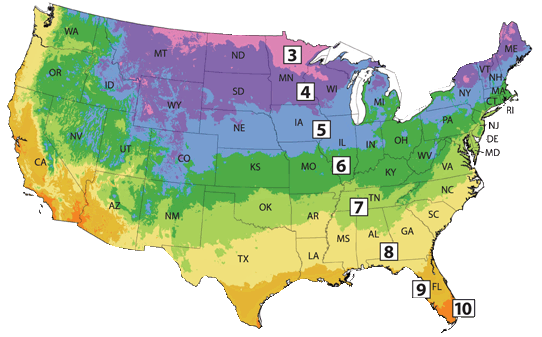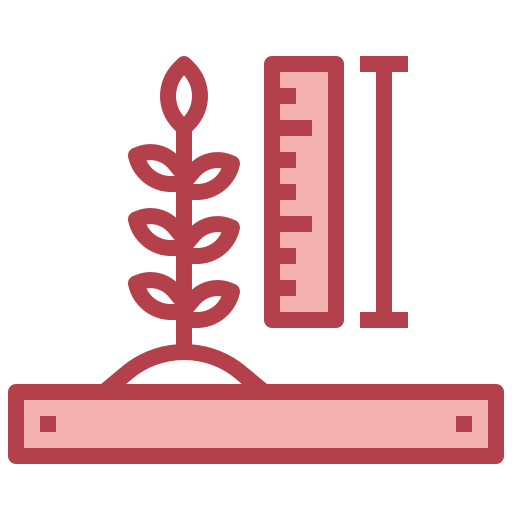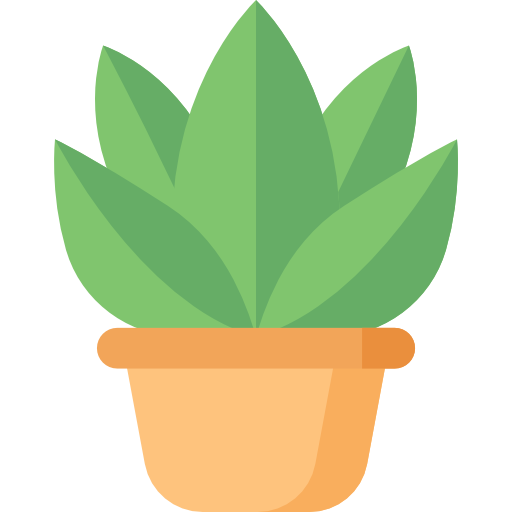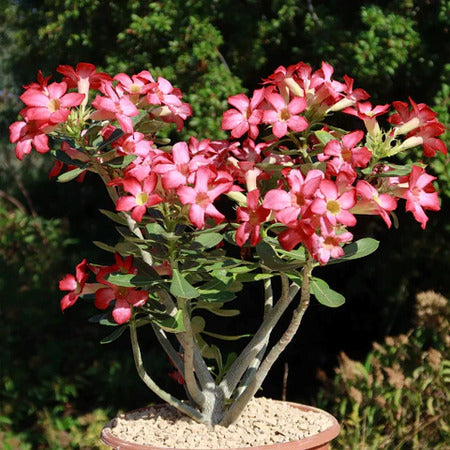Desert Rose – Everything You Need to Know!
Updated: November 03, 2025

The desert rose, known as 'Adenium obesum,' is best loved for its long-lasting, vibrant blooms that appear twice a year, once in early spring and again in late summer or early fall, with each blooming period lasting up to two months. Despite not being a true rose, this striking succulent steals the spotlight with its vibrant, trumpet-shaped flowers and sculptural, bonsai-like form.
Below, you will learn about the popular 6 varieties of true desert rose plants. Additionally, we will explore the many fascinating features of the rose in the desert succulents and provide tips and advice you need to keep your Adenium Desert Rose Succulent thriving. So, let's dive in and discover everything there is to know about this gorgeous succulent desert rose!
About Desert Rose

The Adenium obesum is the most popular, but the Adenium arabicum variety is also very popular and is most loved by bonsai enthusiasts as it has a larger trunk or caudex.
These beautiful, drought-tolerant desert rose succulents are native to Africa and the Arabian Peninsula Desert, adapting well to arid or semi-arid climates, yet they can all adapt well to tropical and semi-tropical settings.
Adenium flowers have an irresistible charm that makes people fall in love with the flowers, which are not actually roses but rather beautiful, vibrant, trumpet-shaped blooms that are sure to turn heads.
Desert roses can grow up to 10 feet tall but grow slowly, so it's unlikely that they would grow 12 inches per year. Their growth rate can vary depending on various factors such as the specific variety, growing conditions, and care provided.
The Desert Rose is prized for its natural bonsai-like appearance, especially when shaped from compact varieties like Adenium arabicum. An interesting fact about the Desert Rose is that Adenium obesum can be grown either as a tall, sculptural plant resembling an elephant’s foot or trained into a compact, artistic bonsai.
Desert Rose Flowers
The desert rose plant is cherished for its long-lasting, vibrant blooms that appear twice a year—once in early spring and again in late summer or early fall, with each blooming period lasting up to two months. The first flush of blossoms typically appears in early spring and continues steadily through mid-summer, assuming it receives enough light. Even though the bright sun encourages flower production, the Desert Rose often takes a natural break during the hottest and rainiest part of the season. So, during winter and periods of extreme heat or heavy rain, it enters a resting phase before resuming its blooming cycle.
Blossoming resumes again in the early autumn months, bringing a second wave of vibrant flowers. Give your desert rose plant a good pruning after the first bloom cycle, and bring it indoors once temperatures begin to drop below 55 degrees Fahrenheit to protect it from cold stress.

The desert rose is known for its striking, showy, fragrant flowers, which are typically pink or red and can be up to 3 inches in diameter. The flowers of the desert rose are trumpet-shaped and have five petals that are arranged in a star shape. The flowers are highly fragrant and attract a variety of pollinators, including bees and butterflies.
The desert rose flowering plant, thrives well in desert settings and will bloom exquisitely in full, bright sun. They can also thrive in bright morning or afternoon sun, though they may not flower as profusely. These plants get lanky and weak-stemmed if kept in the shade.
Wildlife - Desert Rose Flowers Attract the Following Friendly Pollinators
Desert rose flowers attract a variety of friendly pollinators, including bees, butterflies, and hummingbirds. These pollinators are essential for the reproduction of the flowers and play a crucial role in maintaining biodiversity in the desert ecosystem.
 Butterflies
Butterflies
 Bees
Bees
 Hummingbirds
Hummingbirds
 Lady Bugs
Lady Bugs
 Multi Pollinators
Multi Pollinators
 Other Birds
Other Birds
According to the ASPCA, the Desert Rose is mildly toxic to both pets and humans if ingested in large amounts, as its milky sap contains cardiac glycosides. However, it is safe to touch and easy to handle, making it a popular choice as an indoor plant. Just be sure to keep it out of reach of pets and children who may chew on leaves or stems.
How to Care for Desert Rose Plants
Maintaining a desert rose plant is simple, but it does require a bit of knowledge. Indeed, these rugged desert dwellers adapt to almost any situation as long as they have plenty of sun, warmth, and well-draining soil. In very hot climates, Desert Rose is happy and prolific outdoors all year round in USDA zones 11-12, and happy indoors in other zones. These desert rose plants love to be in the direct sun with temperatures of at least 70°F, but they can do very well in temperatures of up to 100°F.
Quick Reference

Bloom Season

Flower Color

Growth Rate

Hardiness Zone

Mature Size

Plant Type

Sun Exposure

Toxicity

Watering Needs
Water moderately in warm weather and sparingly in cool weather
The Desert Rose enjoys a nice, warm rainy season, but when cool weather comes, you’ll need to cut back on watering. Some say it is best to think of your Adenium as a tropical plant in the spring and summer and as a cactus in the autumn and winter.

From the spring through early fall, during the warm growing season, they prefer watering once every 7-10 days to support active growth, budding, and blooming. When the soil feels completely dry about two inches down, or passes the “two-finger dry test,” water slowly and carefully. The most important thing to remember is that the roots should never become waterlogged.
In cooler weather or from late fall through winter, watering should be reduced to as little as once every 3–4 weeks, or even less, depending on indoor humidity and temperature levels. Overwatering can become dangerous, leading to root rot or a mushy caudex. If the plant is kept in a cooler environment, it's best to err on the side of underwatering.
Ideal Lighting Needs for Desert Rose
When grown indoors, the desert rose needs at least 6 hours of bright, direct sunlight each day to thrive and produce blooms. A south- or west-facing window is ideal, as it provides the intense light this plant craves. Without enough light, the plant may become leggy and fail to flower. During winter, if natural light is limited, consider supplementing with a grow light to keep it healthy and active.
In the United States, this is mostly an indoor plant; it can only be grown outdoors year-round in Hawaii in full sun to partial shade. If transitioning from indoors to outdoors in spring or summer, do so gradually to avoid sunburn. In extreme heat or during heat waves, offer temporary protection by moving the plant to a partially shaded spot or using a shade cloth, especially in desert regions.
Choosing the Right Soil & Fertilizer Requirements

The desert rose likes fast-draining soil, as it is important to avoid excess moisture because this can promote root and stem rot.
We believe the best option is to use our specialty succulent potting mix that contains 5 natural substrates and organic mycorrhizae to promote the development of a strong root system that helps your succulent desert rose to thrive.
Feed once a year in spring with a balanced 5-10-5 fertilizer. During the growing season, a light feeding helps promote blooming and healthy growth. As the weather cools, stop feeding to allow the plant to wind down for the winter.
If you bring your Adenium plant indoors for the winter, you may want to give it one weak fertilizer in mid-winter; however, this is not necessary as the plant is likely in a state of semi-dormancy.
The 6 Most Popular Varieties of True Desert Rose Plants
We take pride in offering true varieties of Desert Rose (Adenium obesum)—not generic mixes or unnamed hybrids. Each plant we feature has been carefully selected for its unique color, form, and growth habit, ensuring you receive a genuine and consistent variety. Whether you're drawn to bold reds, vibrant pinks, or multicolored blooms, our collection showcases the best of what the Desert Rose world has to offer. These stunning succulents are not only eye-catching but also reliable growers, ideal for collectors and beginners alike.

1
Desert Rose (Adenium arabicum)
BUY AT PLANET DESERTkeypoints:
- USDA Hardiness Zones:10,11
- Blooming Period: Late Spring, Summer, Fall
- Mature Size: 9 ft. tall
- Flower Color: Pink, White, Yellow, Red
Adenium obesum var. arabicum, also known as the Desert Rose, is a stunning succulent native to the arid regions of Africa and the Arabian Peninsula. The Arabicum variety is the most popular Desert Rose, and people love the bonsai-like look. It is characterized by its thick, larger caudex resembling a miniature baobab tree and beautiful clusters of pale pink flowers that range in color from pink and red to white. Its wider, light green, fleshy leaves with tiny hairs are arranged in a spiral pattern, adding to its unique aesthetic appeal. It is monoecious and self-sterile, and drought-tolerant leaves. Lear more...

2
Desert Rose (Adenium obesum)
BUY AT PLANET DESERTkeypoints:
- USDA Hardiness Zones:10, 11, 12
- Blooming Period: Spring, Autumn
- Mature Size: 9 ft. tall, 5 ft. wide
- Flower Color: White, pink, red, yellow, rose
The dazzling Desert Rose, also known as 'Adenium obesum', is the second most popular variety. This slow-growing plant is characterized by its unique swollen trunk, vibrant, bright flowers, and waxy, shiny, narrow leaves, unlike the arabicum broader and rounded leaves, making it an excellent choice for xeriscaping gardens or indoor cultivation. It is also used as a desert rose bonsai or adenium obesum bonsai plant! It's easy to fall in love with this stunning beauty. Learn more...

3
Impala Lily Desert Rose (Adenium obesum swazicum)
BUY AT PLANET DESERTkeypoints:
- USDA Hardiness Zones: 10, 11
- Blooming Period: Late Summer, Fall
- Mature Size: 28 in. tall, 6 in. wide
- Flower Color: Pink, deep reddish pink
Adenium obesum subsp. swazicum is also referred to as the desert rose and the summer impala lily. This variety of desert rose plants enjoys warm weather, is a dwarf that typically has a few short stems, and doesn't grow larger. If you have an Adenium swazicum plant sending out long shoots, it's a good idea to prune it as a way of guiding and controlling plant growth. Learn more...

4
Socotran Desert Rose (Adenium obesum socotranum)
BUY AT PLANET DESERTkeypoints:
- USDA Hardiness Zones: 10, 11
- Blooming Period: Spring
- Mature Size: 15 ft. tall, 8 ft. wide
- Flower Color: Pink
This Socotran desert rose, also known as Adenium obesum subsp socotranum, is a sun-loving tropical species that is indigenous to the Indian Ocean Island between Yemen and Somalia. The developing plant has a trunk and is mostly known as the Desert Rose grafted plant. In the spring and summer, when the plant has no leaflets, colorful flowers appear. Learn more...

5
Adenium obesum somalense
BUY AT PLANET DESERTkeypoints:
- USDA Hardiness Zones: 10, 11
- Blooming Period: Spring
- Mature Size: 16 ft. tall
- Flower Color: White, pink, crimson red
The Adenium obesum somalense, a sun-loving desert rose plant from Eastern Africa, is renowned for its twisted branches and narrow blade-like leaves that reach towards the sky. It's not just its unique appearance that makes it stand out, though; this beauty has a swollen, typically twisted trunk that adds character and charm. And let's talk about those trumpet-shaped flowers! They come in colors red, white, or pink, making them a feast for the eyes against their arid surroundings. Learn more...

6
Adenium obesum shada
BUY AT PLANET DESERTkeypoints:
- USDA Hardiness Zones: 10, 11, 12
- Blooming Period: Spring
- Mature Size: 9 ft. tall, 5 ft. wide
- Flower Color: Pink, White
The Adenium obesum shada evergreen succulent shrub is a visually stunning, plant with its broad, leathery, dark green leaves. The main difference between them lies in their flower color and pattern. Adenium shada typically has white or light-colored flowers, while Adenium obesum can have a wider range of flower colors, including pink, red, and even multicolored varieties. No wonder it's frequently cultivated as a bonsai in semi-arid climates. Learn more...
Understanding Desert Rose Indoor Temperature & Humidity
When growing indoors as a houseplant, the ideal temperature range for your Desert Rose is between 65 and 90°F. Always keep them warm; they will die fast if exposed to temperatures below 50 degrees Fahrenheit for an extended period of time.
Since Desert Roses are native to arid regions, they prefer low humidity and are quite tolerant of the dry indoor air typical in many homes. A bright, sunny spot, such as a south-facing window, will keep your plant healthy and encourage strong blooming indoors.
Growing Desert Rose Outdoors

Outdoors, Desert Roses flourish year-round only in USDA zones 11–12, such as parts of Hawaii and southern Florida.
In other regions, you can still enjoy them outside during warmer months if you grow them in pots.
Once nighttime temperatures consistently stay above 50°F, you can safely move your Desert Rose outdoors for the season. Choose a sunny, sheltered location, and enjoy their vivid flowers all summer long.
However, as fall approaches and temperatures start to dip, it’s crucial to bring your plant back inside to protect it from cold damage and ensure it lives for many years.
Overwintering Desert Roses
Desert roses cannot survive frost or prolonged cold. Bring your desert rose indoors when the temperature drops below 50 degrees Fahrenheit. Find a bright spot near a window where it can still get sunlight.

During the winter, desert roses go into a dormant phase, so you'll want to reduce watering and let the soil dry out between waterings. Keep the temperature above 50°F and protect it from drifting. If the light indoors is not sufficient, consider using grow lights. Keep an eye out for pests and take action if necessary.
Is Regular Pruning Necessary?

The desert rose plants can grow quite large; a combination of pruning and under-potting is essential to keep them at a manageable size. A regular pruning schedule will help keep your plant fresh, vigorous, and well-groomed.
During the growing season, pinch back or prune stray growth. Before bringing the plant indoors for winter, prune back excessive growth, as this will make the rest period more effective for the plant.
Additionally, it will be easier to keep a smaller, more compact plant stem growth symmetrically, indoors during the winter months.
Before putting the plant back outdoors for the growing season, good trimming is a smart idea. Trim off any dead or damaged vegetation. Cut back straggly branches to improve the plant’s shape. You can use these branches as cuttings to create new growth.
What Kind of Pot is Best for Desert Rose?
- Terracotta clay pots are best because they’re porous and help prevent overwatering. They allow better air flow to the roots and reduce the risk of rot. Shallow terracotta bowls also look great and support healthy growth.
- If you use a saucer, make sure there is no water in it. You can use pots made of almost any material when planting Desert Rose. Just make sure the container is sturdy because Adenium's aggressive root growth can burst flimsy plastic containers. Any growing container must have ample drainage holes in the bottom.
- Low, wide pots are better for healthy root spread and plant stability. Tall, thin pots can restrict growth and create a carrot-shaped root structure, which helps form a thick caudex but limits overall development. Some growers start in a tall pot for caudex shape, then move the plant to a squat container to expose roots and support fuller growth.
Desert Rose Bonsai Pots & Care Tips
To create a desert rose bonsai, get a special bonsai pot, or a small pot that will restrict root and plant growth by restricting plant growth, they grow less tall and become a bonsai. The term "bonsai" refers to the traditional Japanese art of growing decorative, dwarfed kinds of trees and shrubs in trays, pots, or other containers. Adenium bonsai truly means "planted in a container" and is a symbol of love, fertility, and health.
How Often Should You Repot Desert Roses?
The desert rose plants are relatively slow-growing, and they should not need repotting more often than once every two or three years. When planting a desert rose, be careful not to provide an oversized container, as this will encourage root growth and may detract from the number of blooms your plant produces.
Select an attractive container that gives your desert rose succulent plant’s root mass one or two extra inches for growth all the way around. Make sure to shake the old soil off the roots and completely replace it with fresh, new, nourishing, well-draining potting mix
Like other succulent plants, use cactus potting soil when replanting the desert rose. These desert rose flower plants want well-drained soil to prevent stem and root rot.
Propagation of Adenium Plants from Cuttings and Seeds
If you want a Desert Rose with a large, swollen caudex (the thick, sculptural base), starting from seed is the best option. When you grow Desert Rose from a cutting, the plant typically won’t form a dramatic caudex above the soil. Instead, it develops underground, though you can carefully expose the base later without harming the plant.

The advantage of starting from a cutting is that you can do lots of interesting things, such as grafting cuttings that produce one flower color onto plants that produce another color. You can also graft several different cuttings together to form an artistic grouping.
In Europe, you sometimes find the Desert Rose grafted onto an Oleander stock. The Oleander graft combination allows the Desert Rose to grow faster and produce more flowers.
How to Propagate Desert Rose from Cuttings:
If you have a plant sending out long shoots, it’s a good idea to prune as a way of guiding and controlling plant growth. You can use the pruned sections to create brand-new, interesting plants.
- Cuttings at least 6 inches long are ideal for rooting succulent stems. Sort through the shoots after pruning the plant and select the best ones.
- Place them in a warm, dry area away from direct sunlight, and spread them out on a newspaper or a paper towel. Let the cuttings dry for 48 hours.
- After two days, prepare a pot or container with a gravelly, well-drained potting mix.
- Dust the cut end with rooting powder and insert it into the planting mix. To thoroughly soak the planting mixture, use a spray bottle. Mist every couple of days to keep the soil moist, but be sure not to allow it to become thoroughly drenched. Desert Rose does not like to be waterlogged, and the roots will quickly rot if you allow the soil to stay too wet.
- Place your developing plant in a warm, bright, still area either indoors or outdoors, and keep a close eye on it. If you are using an indoor location, be sure to turn the growing plant every day or two so it will get even sunlight. Otherwise, it will tend to bend toward the sun.
- When it begins to sprout new leaves, you’ll know it is well-established enough to move the young plant to a sunnier place. Mature, well-established Desert Rose plants enjoy bright, full sunlight. They can be planted directly into the ground outdoors, but because they are tropical and not cold-hardy at all, it is usually better to plant them in containers to make moving indoors for the winter easier.
How to Sow Desert Rose Seeds
- To plant seeds, start with a well-drained soil mix. Use a shallow pot or a tray placed in an area with bright indirect light. You may want to use a warming pad to keep the growing medium at a steady temperature of 80 to 85°F.
- Evenly sprinkle the seeds over the surface of the growing medium and cover them very lightly with a thin layer of sand.
- Use a spray bottle to saturate the growing medium evenly with water. This process should be repeated on alternate days until the seeds sprout.
- Seedlings should sprout within three to seven days. Every couple of days, keep misting them to keep them evenly and lightly watered. Seedlings should be large enough to transplant into individual containers in about a month.

How to Harvest Desert Rose Seed Pods
The advantage of propagating Desert Rose from seed is that you can be sure of growing plants that develop the thick, bulbous, fat base above-ground caudex that makes these plants so interesting and attractive. It will take several years for the Caudex to develop, so be patient!
You can buy Adenium seeds online or from specialty nurseries; however, be careful to get fresh seeds. The fresher the seed, the better your results will be. If you have several plants for cross-pollination, you can harvest desert rose plant seeds from your plants at the end of the growing season and plant the seeds in the springtime.
For seeds on your plants, look for the development of bean-like seed pods. These usually appear in pairs. As the pods ripen, they will begin to look swollen. At this point, you may want to place a net bag over the pods and secure it with a twist tie, twine, or a rubber band. This will prevent your seeds from flying away when the seed pod bursts.
When the pod bursts, gather the seeds and remove the dandelion-like fluff from the ends. Plant the fresh seeds right away for the best results.
Medicinal Value of Desert Rose
Desert rose adenium has been used to make traditional medicines all over the world. The entire local Adenium obesum species is significant and has historically been utilized in medicine to help cure a variety of illnesses.
The paste of the entire desert rose plant is used mostly to cure sexual problems in Omani culture. Desert rose is a helpful plant having anti-cancer, anti-parasitic, and anti-microbial qualities. Additionally, it can strengthen the immune system, lessen discomfort, inhibit garden pests, treat tooth infections, heal wounds, and treat nose illnesses.
Please consult with a healthcare expert before consuming this plant, as the proper dosage is unknown.
Common Pests and Problems With Desert Rose
Desert rose is a relatively disease- and pest-free plant. However, it can be susceptible to the most common problems.

- Aphids: These tiny insects can infest the leaves and stems, causing damage and stunted growth. Use insecticidal soap or neem oil to control them.
- Mealybugs: These small, white, cotton-like insects can be found on the plant's leaves and stems. They suck sap from the plant, leading to weak growth. Remove them manually or use insecticidal soap.
- Oleander caterpillars: If you notice caterpillars on your plant, pick them off by hand (wear gloves) and treat the plant with Bacillus thuringiensis (Bt) as quickly as possible. These caterpillars can quickly defoliate your plant, but don't give up. Once the caterpillars are in check, the plant will quickly regenerate with fresh, dark green leaves.
- Spider Mites (Tetranychus urticae): These tiny pests can create webbing on the leaves and cause yellowing or stippling. Regularly misting the plant and using insecticidal soap can help control them.
- Root Rot: The most pervasive problem for Desert Rose is root rot. Over-watering should be avoided at all costs. These plants retain water in their thick roots. They do not need or want to stand in water, so it is far better to err on the side of underwatering when it comes to watering. Remember to water sparingly and make sure your plant’s drainage system is working properly.
- Leaf Spot: Powdery mildew is a fungus that causes blister-like marks on upper leaf surfaces and distorted growth. It spreads more frequently during cool, damp nights and warm days. To prevent it, mist leaves, apply a fungicide, prune when stems and branches bunch up, and maintain adequate plant spacing.
-
Leaf Drop or Yellowing of Leaves: A fungal disease called Anthracnose is sometimes a problem for Adenium. If your plant’s leaves develop tan lesions and then turn yellow or cause sudden leaf loss, Anthracnose is probably the problem.
This disease usually occurs in the early summer or in the autumn and resolves on its own. Just reduce watering and rake up the fallen leaves to remove the fungus spores. Your plant should recover nicely. - Sunburn: Desert Rose plants can get sunburned if exposed to intense sunlight without acclimation. Gradually introduce them to direct sunlight to avoid sunburn.
Remember to regularly inspect your Desert Rose plants for any signs of pests or problems and take appropriate action to keep them healthy.

Where to Buy Desert Rose?
When it comes to buying a Desert rose, unless you have a local nursery that specializes in succulents, you may have a hard time finding a Desert Rose near you. Planet Desert is your easiest and best option if you're looking to buy affordable cacti online and have them conveniently shipped right to your door!
Here is the link to Our Desert Rose Product Page. At Planet Desert, we have a large selection of over 500 cacti & succulents in stock, and we guarantee they will arrive happy and healthy.
Key Highlights
- The Desert Rose produces stunning, long-lasting blooms in vibrant shades of pink, red, and white, often lasting up to two months and appearing twice a year.
- Its naturally thick caudex and sculptural branches give it strong bonsai appeal, making it a favorite among bonsai enthusiasts.
- This drought-tolerant succulent stores water in its swollen stem and roots, allowing it to survive extended dry periods with minimal care.
- Desert Rose plants can live for decades with proper care, developing into striking, tree-like specimens that serve as long-term focal points in any garden or home.
- The desert rose is a slow-growing plant, only growing about 12 inches per year.
- In the US, it is a popular indoor plant that requires bright, direct sunlight for 4-6 hours daily.
Final Thoughts
Overall, the Desert Rose (or Spurge plant) is a rugged, long-lived succulent prized for its long-lasting, fragrant blooms, sculptural form, and versatility; it can be grown in the landscape, kept in containers, styled as bonsai, or even used in creative displays like upside-down planting. Thriving in warm conditions and resting during cooler months, this plant offers year-round interest, especially in climates with seasonal transitions. With proper care, like well-draining soil, seasonal watering, and protection from pests such as aphids and mealybugs, Desert Rose can become a lifelong companion that brings lasting beauty and enjoyment to any gardener.
Desert Rose Quick-Growing Reference Guide
| Bloom Season | Early Spring, Mid-Summer |
|---|---|
| Botanical Name | Adenium obesum |
| Common Name | Desert rose, Sabi star, mock azalea, impala lily |
| Dormancy | Winter |
| Family | Apocynaceae |
| Flower Color | Pink, red, rose, white, yellow |
| Genus | Adenium |
| Growth Habit | Shrub |
| Growth Rate | Slow |
| Hardiness Zone | 11, 12 |
| Mature Size | 10 ft. tall, 6 ft. wide |
| Native Area | Tropical Africa, Arabian Peninsula |
| Plant Type | Succulent |
| Propagation | By stem cuttings, seeds |
| Resistance | Drought tolerant, heat resistant, pest resistant |
| Soil PH | 6.5, Acidic, Neutral |
| Soil Type | Succulent potting mix soil |
| Special Features | Showy flowers, used as bonsai |
| Sun Exposure | Full sun, partial shade |
| Toxicity | Mildly toxic to humans, mildly toxic to pets (Keep away from children) |
| Watering Needs | Moderate |
Frequently Asked Questions
-
Is Desert Rose an indoor plant?
Desert rose (Adenium obesum) is a beautiful indoor plant that requires bright, direct sunlight for 4-6 hours daily. It thrives near a south-facing window or under grow lights. It prefers warm temperatures, with a minimum of 60–65 °F during the winter. Well-draining soil is essential, and watering should be thorough but allow for drying. With proper care, you can grow adenium obesum indoors to add exotic beauty.
-
Is the Desert Rose plant poisonous?
The sap of the desert rose (Adenium obesum) plant can be harmful if ingested, so it is important to keep the plant out of reach of children and pets. When handling the desert rose, it is a good idea to wear gloves and take care not to get the sap on your skin or in your eyes. With proper care and attention, however, the desert rose can be a beautiful and rewarding plant to grow and enjoy.
-
Is desert rose a lucky plant?
In Chinese cultures, the desert rose is considered a lucky plant that brings good fortune and prosperity to the home. In Feng Shui, for example, the desert rose is believed to attract positive energy and promote wealth and success. The plant is also sometimes associated with love and romance, and it is said to help create a harmonious and peaceful atmosphere in the home. While there is no scientific evidence to support these claims, the desert rose is a beautiful and unique plant that can add a touch of exotic beauty to any space, and it is certainly a plant worth growing and enjoying for its own sake.
-
Why is Adenium obesum called a desert rose?
The Adenium obesum desert rose is not actually a true rose, but it earned its name because its flower shape resembles that of a rose. Just like a rose, it showcases stunning and intricate flower formations. However, unlike traditional roses, the desert rose has adapted to survive in harsh conditions with limited water availability. Its thick, succulent-like stems and leaves store water, allowing it to withstand long periods of drought.























